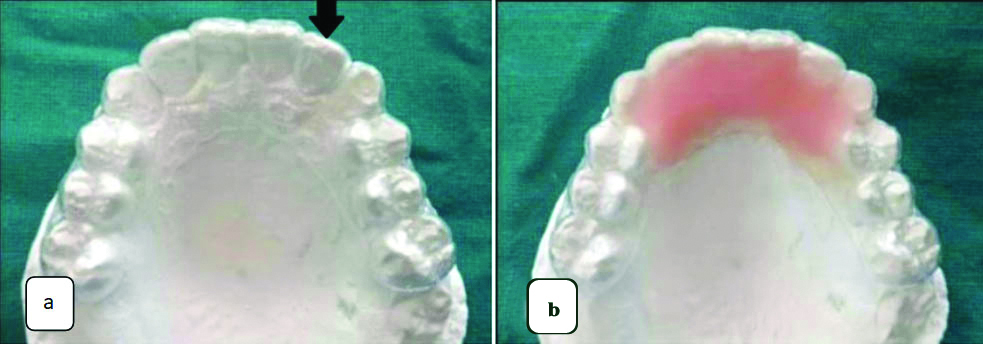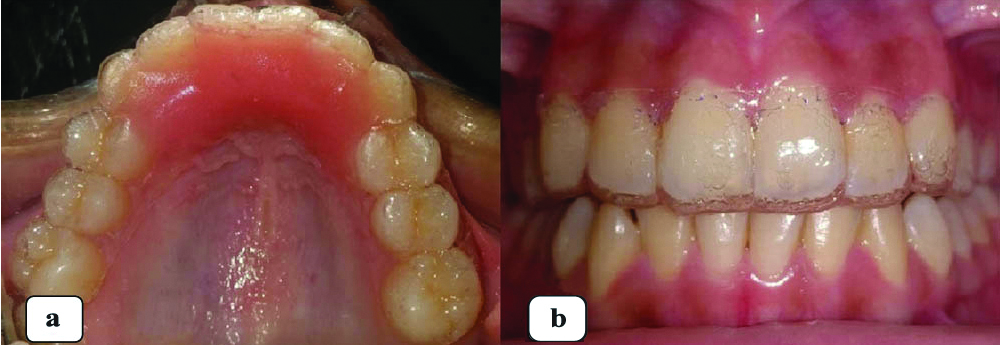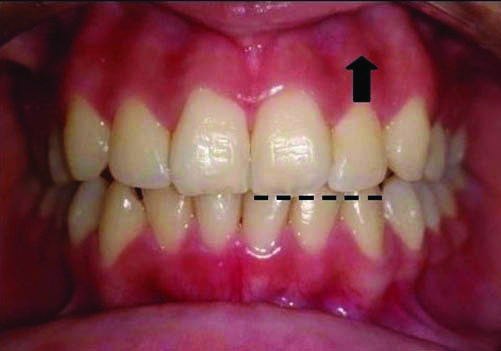Esthetic Simultaneous Intrusion and Retention (E-SIR) Appliance
Ram Gopal1, Tulika Tripathi2, Priyank Rai3, Prateek Gupta4
1 Faculty, Department of Orthodontics and Dentofacialortho, Maulana Azad Institute of Dental Sciences, Delhi, India.
2 Faculty, Department of Orthodontics and Dentofacialortho, Maulana Azad Institute of Dental Sciences, Delhi, India.
3 Faculty, Department of Orthodontics and Dentofacialortho, Maulana Azad Institute of Dental Sciences, Delhi, India.
4 Faculty, Department of Orthodontics and Dentofacialortho, Maulana Azad Institute of Dental Sciences, Delhi, India.
NAME, ADDRESS, E-MAIL ID OF THE CORRESPONDING AUTHOR: Dr. Tulika Tripathi, Maulana Azad Institute of Dental Sciences, MAMC Complex, BSZ Marg, Delhi, India.
E-mail: drtulikatripathi@yahoo.com
Esthetics is the chief concern with which the patient approaches to an orthodontist. Orthodontists are gearing up to make the treatment esthetic in both the active and the retentive phase. Here, we present a relapsed case of 15-year-old female patient who got her fixed treatment done and was wearing Hawley’s appliance with anterior bite plane as retainer irregularly. Getting an orthodontic treatment again with fixed braces or clear aligners would be both exhausting and expensive for the patient. Clear appliances can be made with a pressure molding machine for minor tooth corrections in clinical set-up. Thus, this article is intended to introduce a novel esthetic retainer which provides both retention following orthodontic treatment and correction of extruded upper left lateral incisor as intrusion cannot be performed with conventional retainers. Compared with conventional removable orthodontic retainers, present appliance is more esthetic, comfortable and inexpensive.
Clear retainer,Deep-bite retention,Modified aligner
Case Report
A 15-year-old female patient who got her fixed treatment done and was using removable retainer with anterior bite plane irregularly complained of extruded upper left lateral incisor and difficulty in speech. Labial wire visibility in appliance, bulkiness and speech difficulty made patient’s acceptance poor for removable retainer [Table/Fig-1]. Because of unesthetic nature of appliance and extrusion of a front tooth, she was not wearing the appliance regularly especially during school hours.
Hawley’s appliance with anterior bite plane and extruded 22; a) occlusal view; b) frontal view; c) lateral view.

On examination, upper and lower arches were well-aligned with attrition in lower anteriors and extrusion of left upper lateral incisor by 2 mm. Considering the patient’s chief concern due to her age and social activity, it was decided to use a clear retainer with few modifications. Informed consent was obtained. Study models were prepared for analysis and aligner fabrication. In present case, 2 mm intrusion of upper left incisor was needed. Upper left lateral incisor was trimmed in model by 2 mm so that retention aligner may become active in that area and generate an intrusive force on extruded lateral incisor and correct its position. Anterior bite plane was added in clear retainer to maintain the corrected bite [Table/Fig-1,3]. Within 3 months of treatment with the present appliance, 2 mm intrusion of left lateral incisor was accomplished which was maintained after six months of retention [Table/Fig-4]. Moreover, anterior bite plane which was added in the aligner, maintained the corrected deep bite.
a) Trimming of 22 by 2 mm from incisal edge in model so that it can generate an intrusive force on relapsed/extruded lateral incisor; b) Fabrication of clear retainer followed by addition of anterior bite plane with cold cure to maintain the corrected deep bite.

Esthetic clear retainer with anterior bite plane: a) occlusal view; b) frontal view.

After six months of esthetic retention.

Discussion
Esthetics is the core of orthodontics and is one of the main concerns with which patients report to orthodontists. An orthodontist should strive to provide esthetics even in retention phase. Patient’s acceptance for a retention appliance is greatly affected by its visibility.
Teeth have a tendency to return toward their pre-treatment positions. Hence, active management of retention should be executed following orthodontic treatment to prevent any relapse. Various retention appliances were designed in the past like Hawley’s retainer and modified over a period of time to reduce their visibility which materialised into contemporary clear retainers. An esthetic retainer was found superior over conventional Hawley’s retainer by many studies. Atik E et al., concluded that the Hawley’s retainer affects speech more prominently than the clear Essix retainer [1]. Esthetic modification of Hawley’s retainer with a translucent labial bow was introduced by Chudasma D et al., [2]. But, it suffered from limitations of bulkiness and greater palatal coverage. Whereas present esthetic retainer has reduced thickness (Duran aligner sheet of 0.625 mm) and less tissue coverage as compared to acrylic plate (2 mm). Saleh M et al., found that over a six months period of retention, vacuum formed retainer was significantly more acceptable than Hawley’s retainer in terms of speech, appearance, gingival irritation, swallowing, self-confidence and comfort [3]. Potential of clear appliances have been tapped by innovative modifications to perform slight tooth movements previously [4,5]. An esthetic retainer cum trainer has been designed by Tripathi et al., to intercept tongue thrusting habit, which increased patient’s compliance [6]. In the present paper, an esthetic retention appliance was introduced which had an anterior bite plane, that apart from acting as a retainer, maintained the corrected deep bite and simultaneously produced an intrusive force on relapsed upper left lateral incisor [Table/Fig-4]. Only limitation of present esthetic retainer is that it requires a Biostar® machine for its fabrication which may not be available in all dental set ups.
This paper introduced an esthetic retainer which reclaimed relapsed tooth position and saved precious time spent during orthodontic treatment and maintained the patient’s confidence in orthodontists.
Conclusion
The present esthetic retainer (E-SIR) served the purposes of retention, maintenance of corrected deep bite and intrusion of upper left lateral incisor simultaneously. Clear and esthetic appliance improved adolescent patient’s acceptance. As it covered only dentition and had reduced palatal coverage, it was observed to interfere minimally with speech and comfort of the patient. Thus, orthodontists can perform minor modifications in such clear appliances to achieve slight tooth corrections using pressure molding machine.
[1]. Atik E, Aydınlı F, Kayikci M, Ciger S, Comparing the effects of Essix and Hawley’s retainers on the acoustics of speech Eur J Orthod 2017 39:440-45.10.1093/ejo/cjw05027507127 [Google Scholar] [CrossRef] [PubMed]
[2]. Chudasma D, Sheridon J, Jerrold L, Esthetic modification of a Hawley Retainer using a translucent labial bow J Clin Orthod 2009 43:111-12. [Google Scholar]
[3]. Saleh M, Hajeer M, Muessig D, Acceptability comparison between Hawley retainers and vacuum-formed retainers in orthodontic adult patients: a single-centre randomized controlled trial Eur J Orthod 2017 39:453-61.10.1093/ejo/cjx024 [Google Scholar] [CrossRef]
[4]. Tripathi T, Singh N, Rai P, Kalra S, A modified clear aligner Int J Orthod 2016 27:29-31. [Google Scholar]
[5]. Abraham KK, James AR, Thenumkal E, Emmatty T, Correction of anterior crossbite using modified transparent aligners: An esthetic approach Contemp Clin Dent 2016 7:394-97.10.4103/0976-237X.18857727630508 [Google Scholar] [CrossRef] [PubMed]
[6]. Tripathi T, Kalra S, Rai P, Aesthetic retainer cum trainer J Clin Diagn Res 2017 11:1-2.10.7860/JCDR/2017/23107.915328274080 [Google Scholar] [CrossRef] [PubMed]